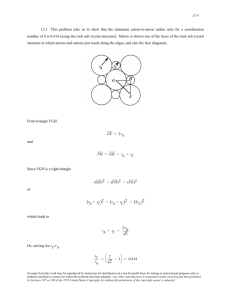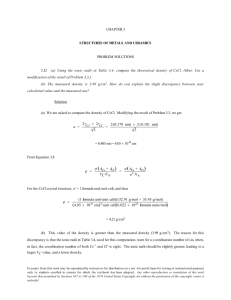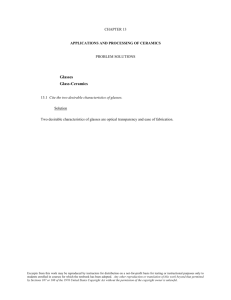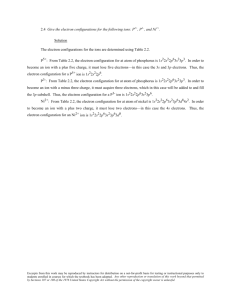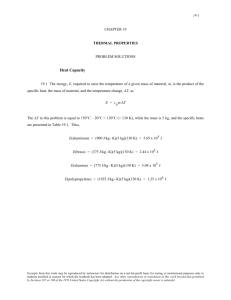Chapter 21 - Aerostudents
advertisement
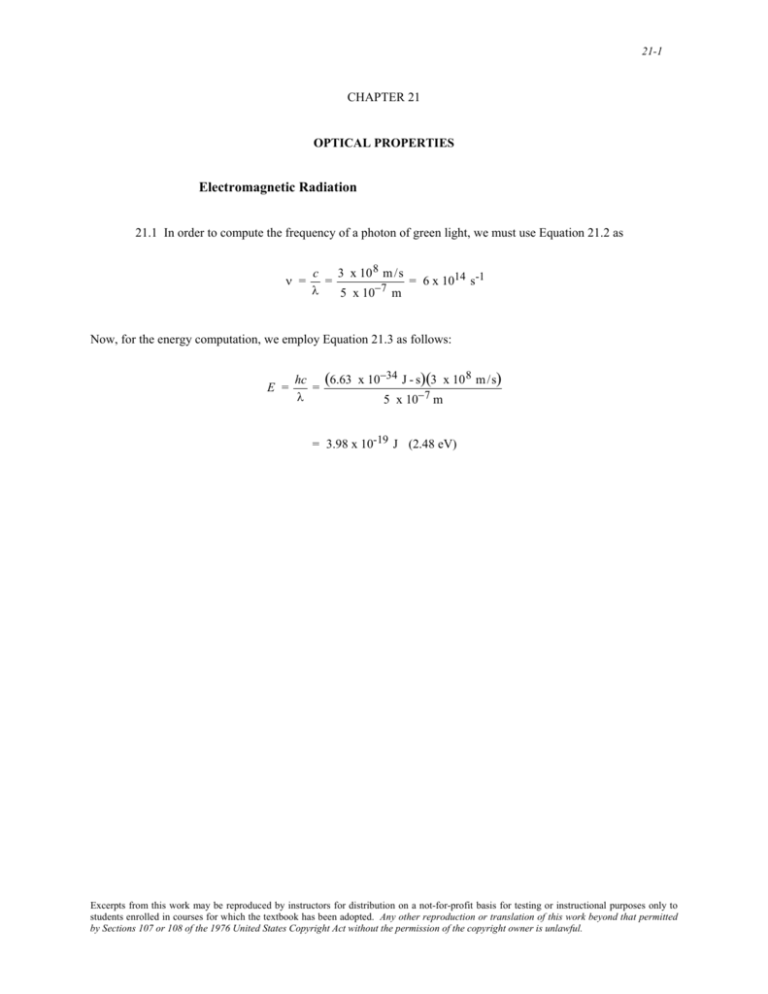
21-1 CHAPTER 21 OPTICAL PROPERTIES Electromagnetic Radiation 21.1 In order to compute the frequency of a photon of green light, we must use Equation 21.2 as ν = c 3 x 10 8 m /s = = 6 x 1014 s-1 −7 λ 5 x 10 m Now, for the energy computation, we employ Equation 21.3 as follows: E = hc (6.63 x 10−34 J - s)(3 x 10 8 m /s) = λ 5 x 10−7 m = 3.98 x 10-19 J (2.48 eV) Excerpts from this work may be reproduced by instructors for distribution on a not-for-profit basis for testing or instructional purposes only to students enrolled in courses for which the textbook has been adopted. Any other reproduction or translation of this work beyond that permitted by Sections 107 or 108 of the 1976 United States Copyright Act without the permission of the copyright owner is unlawful. 21-2 Light Interactions with Solids 21.2 Opaque materials are impervious to light transmission; it is not possible to see through them. Light is transmitted diffusely through translucent materials (there is some internal light scattering). Objects are not clearly distinguishable when viewed through a translucent material. Virtually all of the incident light is transmitted through transparent materials, and one can see clearly through them. Excerpts from this work may be reproduced by instructors for distribution on a not-for-profit basis for testing or instructional purposes only to students enrolled in courses for which the textbook has been adopted. Any other reproduction or translation of this work beyond that permitted by Sections 107 or 108 of the 1976 United States Copyright Act without the permission of the copyright owner is unlawful. 21-3 Atomic and Electronic Interactions 21.3 (a) The phenomenon of electronic polarization by electromagnetic radiation is described in Section 21.4. (b) Two consequences of electronic polarization in transparent materials are absorption and refraction. Excerpts from this work may be reproduced by instructors for distribution on a not-for-profit basis for testing or instructional purposes only to students enrolled in courses for which the textbook has been adopted. Any other reproduction or translation of this work beyond that permitted by Sections 107 or 108 of the 1976 United States Copyright Act without the permission of the copyright owner is unlawful. 21-4 Optical Properties of Metals 21.4 The electron band structures of metals are such that empty and available electron states are adjacent to filled states. Electron excitations from filled to empty states are possible with the absorption of electromagnetic radiation having frequencies within the visible spectrum, according to Equation 21.6. The light energy is totally absorbed or reflected, and, since none is transmitted, the material is opaque. Excerpts from this work may be reproduced by instructors for distribution on a not-for-profit basis for testing or instructional purposes only to students enrolled in courses for which the textbook has been adopted. Any other reproduction or translation of this work beyond that permitted by Sections 107 or 108 of the 1976 United States Copyright Act without the permission of the copyright owner is unlawful. 21-5 Refraction 21.5 In ionic materials, the larger the size of the component ions the greater the degree of electronic polarization. Excerpts from this work may be reproduced by instructors for distribution on a not-for-profit basis for testing or instructional purposes only to students enrolled in courses for which the textbook has been adopted. Any other reproduction or translation of this work beyond that permitted by Sections 107 or 108 of the 1976 United States Copyright Act without the permission of the copyright owner is unlawful. 21-6 21.6 In order for a material to have an index of refraction less than unity, the velocity of light in the material (v) would necessarily have to be greater than the velocity of light in a vacuum (Equation 21.7). This is not possible. Excerpts from this work may be reproduced by instructors for distribution on a not-for-profit basis for testing or instructional purposes only to students enrolled in courses for which the textbook has been adopted. Any other reproduction or translation of this work beyond that permitted by Sections 107 or 108 of the 1976 United States Copyright Act without the permission of the copyright owner is unlawful. 21-7 21.7 We want to compute the velocity of light in diamond given that εr = 5.5 and χm = -2.17 x 10-5. The velocity is determined using Equation 21.8; but first, we must calculate the values of ε and µ for diamond. According to Equation 18.27 ε = εr ε0 = (5.5)(8.85 x 10-12 F/m) = 4.87 x 10-11 F/m Now, combining Equations 20.4 and 20.7 µ = µ 0 µr = µ 0 (χ m + 1) = (1.257 x 10-6 H/m)(1 − 2.17 x 10-5) = 1.257 x 10-6 H/m And, finally, from Equation 21.8 v = = 1 εµ 1 (4.87 x 10−11 F / m)(1.257 x 10−6 H / m) = 1.28 x 10 8 m/s Excerpts from this work may be reproduced by instructors for distribution on a not-for-profit basis for testing or instructional purposes only to students enrolled in courses for which the textbook has been adopted. Any other reproduction or translation of this work beyond that permitted by Sections 107 or 108 of the 1976 United States Copyright Act without the permission of the copyright owner is unlawful. 21-8 21.8 The frequencies of visible radiation are on the order of 1015 Hz (Figure 21.2). At these frequencies only electronic polarization is operable (Figure 18.34). Thus, εr from Equation 21.10 is the electronic contribution to εr; let us designate it as εr' . Or, in other words εr' = n 2 For fused silica εr' (silica) = (1.458) 2 = 2.13 And, for polystyrene (PS) εr' (PS) = (1.60) 2 = 2.56 The fraction of the electronic contribution is just the ratio of εr' and εr, where εr values are taken from Table 18.5 (4.0 and 2.6 for fused silica and polystyrene, respectively). Thus εr' (silica) = 2.13 = 0.53 4.0 εrÕ(PS) = 2.56 = 0.98 2.60 εr (60 Hz) and εr (60 Hz) Excerpts from this work may be reproduced by instructors for distribution on a not-for-profit basis for testing or instructional purposes only to students enrolled in courses for which the textbook has been adopted. Any other reproduction or translation of this work beyond that permitted by Sections 107 or 108 of the 1976 United States Copyright Act without the permission of the copyright owner is unlawful. 21-9 21.9 This problem asks for us, using data in Table 21.1, to estimate the dielectric constants for silica glass, soda-lime glass, PTFE, polyethylene, and polystyrene, and then to compare these values with those cited in Table 18.5 and briefly explain any discrepancies. From Equation 21.10 εr = n 2 Thus, for fused silica, since n = 1.458 εr = (1.458) 2 = 2.13 Similarly, for soda-lime glass εr = (1.51) 2 = 2.28 And, for PTFE εr = (1.35) 2 = 1.82 For polyethylene εr = (1.51) 2 = 2.28 For polystyrene εr = (1.60) 2 = 2.56 When we compare the values of εr for the polymers with those in Table 18.5 at frequencies of 1 MHz, there is reasonable agreement (i.e., 1.82 versus 2.1 for PTFE, 2.28 versus 2.3 for polyethylene, and 2.56 versus 2.6 for polystyrene). However, for fused silica and soda-lime glass there are some significant discrepancies (i.e., 2.13 versus 3.8 for the fused silica, and 2.28 versus 6.9 for the soda-lime glass). The reason for these discrepancies is that for these two materials an ionic component to the dielectric constant is present at 1 MHz, but is absent at frequencies within the visible electromagnetic spectrum, which frequencies are on the order 109 MHz (1015 Hz). These effects may be noted in Figure 18.34. Excerpts from this work may be reproduced by instructors for distribution on a not-for-profit basis for testing or instructional purposes only to students enrolled in courses for which the textbook has been adopted. Any other reproduction or translation of this work beyond that permitted by Sections 107 or 108 of the 1976 United States Copyright Act without the permission of the copyright owner is unlawful. 21-10 21.10 Dispersion in a transparent medium is the phenomenon wherein the index of refraction varies slightly with the wavelength of the electromagnetic radiation. Excerpts from this work may be reproduced by instructors for distribution on a not-for-profit basis for testing or instructional purposes only to students enrolled in courses for which the textbook has been adopted. Any other reproduction or translation of this work beyond that permitted by Sections 107 or 108 of the 1976 United States Copyright Act without the permission of the copyright owner is unlawful. 21-11 Reflection 21.11 For this problem we want to compute the maximum value of ns in Equation 21.13 that will give R = 0.050. Then we are to consult Table 21.1 in order to ascertain which of the materials listed have indices of refraction less than this maximum value. From Equation 21.13 0.050 = (ns − 1)2 (ns +1)2 = ns2 − 2 ns + 1 ns2 + 2 ns + 1 or, upon rearrangement 0.95 ns2 − 2.10 ns + 0.95 = 0 The value of ns is determined by using the quadratic equation solution as follows: ns = − (−2.10) ± (− 2.10) 2 − (4)(0.95)(0.95) (2)(0.95) = 2.10 ± 0.894 1.90 The two solutions are: ns(+) = 1.576 and ns(–) = 0.634. The ns(+) solution is the one that is physically reasonable. Thus, of the materials listed, soda-lime glass, Pyrex glass, and polypropylene have indices of refraction less than 1.576, and would be suitable for this application. Excerpts from this work may be reproduced by instructors for distribution on a not-for-profit basis for testing or instructional purposes only to students enrolled in courses for which the textbook has been adopted. Any other reproduction or translation of this work beyond that permitted by Sections 107 or 108 of the 1976 United States Copyright Act without the permission of the copyright owner is unlawful. 21-12 21.12 The thickness and dielectric constant of a thin surface coating are selected such that there is destructive interference between the light beam that is reflected from the lens-coating interface and the light beam that is reflected from the coating-air interface; thus, the net intensity of the total reflected beam is very low. Excerpts from this work may be reproduced by instructors for distribution on a not-for-profit basis for testing or instructional purposes only to students enrolled in courses for which the textbook has been adopted. Any other reproduction or translation of this work beyond that permitted by Sections 107 or 108 of the 1976 United States Copyright Act without the permission of the copyright owner is unlawful. 21-13 21.13 This problem calls for a calculation of the reflectivity between two quartz grains having different orientations and indices of refraction (1.544 and 1.553) in the direction of light propagation, when the light is at normal incidence to the grain boundary. We must employ Equation 21.12 since the beam is normal to the grain boundary. Thus, R = = (n2 − n1)2 (n2 + n1)2 (1.553 − 1.544) 2 (1.553 + 1.544) 2 = 8.45 x 10-6 Excerpts from this work may be reproduced by instructors for distribution on a not-for-profit basis for testing or instructional purposes only to students enrolled in courses for which the textbook has been adopted. Any other reproduction or translation of this work beyond that permitted by Sections 107 or 108 of the 1976 United States Copyright Act without the permission of the copyright owner is unlawful. 21-14 Absorption 21.14 This problem asks us to determine the range of visible light wavelengths over which ZnSe (Eg = 2.58 eV) is transparent. Only photons having energies of 2.58 eV or greater are absorbed by valence-band-toconduction-band electron transitions. Thus, photons having energies less than 2.58 eV are not absorbed; the minimum photon energy for visible light is 1.8 eV (Equation 21.16b), which corresponds to a wavelength of 0.7 µm. From Equation 21.3, the wavelength of a photon having an energy of 2.58 eV (i.e., the band-gap energy) is just λ = hc = E (4.13 x 10−15 eV - s)(3 x 10 8 m /s) 2.58 eV = 4.80 x 10-7 m = 0.48 µm Thus, pure ZnSe is transparent to visible light having wavelengths between 0.48 and 0.7 µm. Excerpts from this work may be reproduced by instructors for distribution on a not-for-profit basis for testing or instructional purposes only to students enrolled in courses for which the textbook has been adopted. Any other reproduction or translation of this work beyond that permitted by Sections 107 or 108 of the 1976 United States Copyright Act without the permission of the copyright owner is unlawful. 21-15 21.15 The magnitude of the absorption coefficient (β in Equation 21.18) depends on the radiation wavelength for intrinsic insulators and semiconducting materials. This is because, for photons having energies less hc ), photon absorption due to valence-band-tothan the band-gap energy (or in terms of wavelength, when λ > Eg conduction-band electron transitions are not possible, and, therefore, the value of β will be relatively small. On the hc other hand, when photons having energies equal to or greater than the band gap energy (i.e., when λ ≤ ) these Eg electron transitions by the absorption of photons will occur with the result that the magnitude of β will be relatively large. In addition, there may be impurity levels that lie within the band gap (Section 21.7) from or to which electron excitations may occur with the absorption of light radiation at specific wavelengths. Excerpts from this work may be reproduced by instructors for distribution on a not-for-profit basis for testing or instructional purposes only to students enrolled in courses for which the textbook has been adopted. Any other reproduction or translation of this work beyond that permitted by Sections 107 or 108 of the 1976 United States Copyright Act without the permission of the copyright owner is unlawful. 21-16 21.16 In this problem we are asked to calculate the fraction of nonreflected light transmitted through a 12mm thickness of transparent material, given that the fraction transmitted through a 5-mm thickness is 0.95. From Equation 21.18, the fraction of nonreflected light transmitted is just IT' / I 0' . Using this expression we must first determine the value of β; this is possible by algebraic manipulation of Equation 21.18. Dividing both sides of the equation by I 0' , and then taking natural logarithms leads to ⎛ ' ⎞ ⎜I ⎟ ln ⎜ T ⎟ = − βx ⎜I ' ⎟ ⎝ 0⎠ Now solving for β and also incorporating values for IT' / I 0' and x provided in the problem statement gives β =− ⎛ ' ⎞ 1 ⎜I ⎟ ln ⎜ T ⎟ x ⎜I ' ⎟ ⎝ 0⎠ ⎛ 1 ⎞ -2 -1 = − ⎜ ⎟ ln (0.95) = 1.026 x 10 mm ⎝ 5 mm ⎠ And computation of IT' / I 0' when x = 12 mm (Equation 21.18) is as follows: IT' = exp (− βx) I 0' [ ] = exp − (1.026 x 10−2 mm−1)(12 mm) = 0.884 Excerpts from this work may be reproduced by instructors for distribution on a not-for-profit basis for testing or instructional purposes only to students enrolled in courses for which the textbook has been adopted. Any other reproduction or translation of this work beyond that permitted by Sections 107 or 108 of the 1976 United States Copyright Act without the permission of the copyright owner is unlawful. 21-17 Transmission 21.17 The problem asks that we derive Equation 21.19, which is IT = I 0 (1 − R) 2 e− βl If we examine Figure 21.7, at the front (or left) interface, some of the incident beam having intensity I0 is reflected. Since IR = I0R at this surface, then IT' = I 0 − I 0 R = I 0 (1 − R) in which IT' is the intensity of the nonreflected beam at the front surface that is transmitted. Now there will be absorption of this transmitted beam as it passes through the solid and transparent medium according to Equation 21.18. Just inside the back (or right) interface, the beam has passed through a thickness l of this material (x = l) and, therefore, the intensity of the transmitted beam at this point (I '' ) is just T IT'' = I 0 (1 − R) e- βl Finally, a second reflection will occur at the back interface as the beam passes out of the medium. The intensity of the reflected beam (I '' ) is just R I R'' = I T'' R = I 0 R(1 − R) e- βl And the intensity of the final transmitted beam (IT) becomes IT = IT'' − I R'' = I 0 (1 − R) e- βl − I 0 R(1 − R) e- βl = I 0 (1 − R) 2 e- βl which is Equation 21.19, the desired expression. Excerpts from this work may be reproduced by instructors for distribution on a not-for-profit basis for testing or instructional purposes only to students enrolled in courses for which the textbook has been adopted. Any other reproduction or translation of this work beyond that permitted by Sections 107 or 108 of the 1976 United States Copyright Act without the permission of the copyright owner is unlawful. 21-18 21.18 We are asked to compute the thickness of material to yield a transmissivity of 0.70 given that T is 0.80 when l = 15 mm, n = 1.5, and for normally incident radiation. The first requirement is that we calculate the value of β for this material using Equations 21.13 and 21.19. The value of R is determined using Equation 21.13 as R = = (ns − 1)2 (ns + 1)2 (1.5 − 1) 2 (1.5 + 1) 2 = 4.0 x 10-2 Now, it is necessary to compute the value of β using Equation 21.19. Dividing both sides of Equation 21.19 by I0(1 – R)2 leads to IT I 0 (1 − R) 2 = e -βl And taking the natural logarithms of both sides of this expression gives ⎡ ⎤ IT ⎥ = −βl ln⎢ ⎢⎣ I (1 − R) 2 ⎥⎦ 0 and solving for β we get β =− ⎡ ⎤ IT 1 ⎢ ⎥ ln l ⎢⎣ I (1 − R) 2 ⎥⎦ 0 Since the transmissivity is T is equal to IT/I0, then the above equation takes the form β=− ⎤ 1 ⎡ T ⎥ ln ⎢ l ⎣⎢ (1 − R) 2 ⎥⎦ Using values for l and T provided in the problem statement, as well as the value of R determined above, we solve for β as ⎤ ⎛ 1 ⎞ ⎡ 0.80 ⎥ = 9.43 x 10-3 mm-1 β= −⎜ ⎟ ln ⎢ ⎝ 15 mm ⎠ ⎢⎣ (1 − 4.0 x 10−2 )2 ⎥⎦ Excerpts from this work may be reproduced by instructors for distribution on a not-for-profit basis for testing or instructional purposes only to students enrolled in courses for which the textbook has been adopted. Any other reproduction or translation of this work beyond that permitted by Sections 107 or 108 of the 1976 United States Copyright Act without the permission of the copyright owner is unlawful. 21-19 Now, solving for l when T = 0.70 using the rearranged form of Equation 21.19 above l=− = − ⎤ 1 ⎡ T ⎥ ln ⎢ β ⎢⎣ (1 − R) 2 ⎥⎦ ⎡ ⎤ 0.70 ⎥ ln ⎢ 9.43 x 10−3 mm−1 ⎢⎣ (1 − 4.0 x 10−2 ) 2 ⎥⎦ 1 = 29.2 mm Excerpts from this work may be reproduced by instructors for distribution on a not-for-profit basis for testing or instructional purposes only to students enrolled in courses for which the textbook has been adopted. Any other reproduction or translation of this work beyond that permitted by Sections 107 or 108 of the 1976 United States Copyright Act without the permission of the copyright owner is unlawful. 21-20 Color 21.19 (a) The characteristic color of a metal is determined by the distribution of wavelengths of the nonabsorbed light radiation that is reflected. (b) The characteristic color of a transparent nonmetal is determined by the distribution of wavelengths of the nonabsorbed light radiation that is transmitted through the material. Excerpts from this work may be reproduced by instructors for distribution on a not-for-profit basis for testing or instructional purposes only to students enrolled in courses for which the textbook has been adopted. Any other reproduction or translation of this work beyond that permitted by Sections 107 or 108 of the 1976 United States Copyright Act without the permission of the copyright owner is unlawful. 21-21 21.20 For a transparent material that appears colorless, any absorption within its interior is the same for all visible wavelengths. On the other hand, if there is any selective absorption of visible light (usually by electron excitations), the material will appear colored, its color being dependent on the frequency distribution of the transmitted light beam. Excerpts from this work may be reproduced by instructors for distribution on a not-for-profit basis for testing or instructional purposes only to students enrolled in courses for which the textbook has been adopted. Any other reproduction or translation of this work beyond that permitted by Sections 107 or 108 of the 1976 United States Copyright Act without the permission of the copyright owner is unlawful. 21-22 Opacity and Translucency in Insulators 21.21 The three absorption mechanisms in nonmetallic materials involve electronic polarization, electron transitions, and scattering. Electronic polarization is described in Section 21.4; absorption by electron transitions is discussed in Sections 21.4 and 21.7; and scattering is discussed in Section 21.10. Excerpts from this work may be reproduced by instructors for distribution on a not-for-profit basis for testing or instructional purposes only to students enrolled in courses for which the textbook has been adopted. Any other reproduction or translation of this work beyond that permitted by Sections 107 or 108 of the 1976 United States Copyright Act without the permission of the copyright owner is unlawful. 21-23 21.22 Amorphous polymers are normally transparent because there is no scattering of a light beam within the material. However, for semicrystalline polymers, visible light will be scattered at boundaries between amorphous and crystalline regions since they have different indices of refraction. This leads to translucency or, for extensive scattering, opacity, except for semicrystalline polymers having very small crystallites. Excerpts from this work may be reproduced by instructors for distribution on a not-for-profit basis for testing or instructional purposes only to students enrolled in courses for which the textbook has been adopted. Any other reproduction or translation of this work beyond that permitted by Sections 107 or 108 of the 1976 United States Copyright Act without the permission of the copyright owner is unlawful. 21-24 Luminescence Photoconductivity Lasers 21.23 (a) The phenomenon of luminescence is described in Section 21.11. (b) The feature that distinguishes fluorescence from phosphorescence is the magnitude of the time interval between photon absorption and reemission events. Fluorescence is for delay times less than a second; phosphorescence occurs for longer times. Excerpts from this work may be reproduced by instructors for distribution on a not-for-profit basis for testing or instructional purposes only to students enrolled in courses for which the textbook has been adopted. Any other reproduction or translation of this work beyond that permitted by Sections 107 or 108 of the 1976 United States Copyright Act without the permission of the copyright owner is unlawful. 21-25 21.24 The phenomenon of photoconductivity is explained in Section 21.12. Excerpts from this work may be reproduced by instructors for distribution on a not-for-profit basis for testing or instructional purposes only to students enrolled in courses for which the textbook has been adopted. Any other reproduction or translation of this work beyond that permitted by Sections 107 or 108 of the 1976 United States Copyright Act without the permission of the copyright owner is unlawful. 21-26 21.25 A photographic light meter is used to measure the intensity of incident light radiation. Each photon of incident light induces a valence-band-to-conduction band electron transition in which both electrons and holes are produced, as depicted in Figure 21.5(a). The magnitude of the photoinduced current resulting from these transitions is registered, which is proportional to the numbers of electrons and holes, and thus, the number of incident photons, or, equivalently, the intensity of the incident light radiation. Excerpts from this work may be reproduced by instructors for distribution on a not-for-profit basis for testing or instructional purposes only to students enrolled in courses for which the textbook has been adopted. Any other reproduction or translation of this work beyond that permitted by Sections 107 or 108 of the 1976 United States Copyright Act without the permission of the copyright owner is unlawful. 21-27 21.26 Section 21.13 contains a description of the operation of a ruby laser. Excerpts from this work may be reproduced by instructors for distribution on a not-for-profit basis for testing or instructional purposes only to students enrolled in courses for which the textbook has been adopted. Any other reproduction or translation of this work beyond that permitted by Sections 107 or 108 of the 1976 United States Copyright Act without the permission of the copyright owner is unlawful. 21-28 21.27 This problem asks for the difference in energy between metastable and ground electron states for a ruby laser. The wavelength of the radiation emitted by an electron transition from the metastable to ground state is cited as 0.6943 µm. The difference in energy between these states, ∆E, may be determined from a combined form of Equations 21.6 and 21.2, as ∆E = hν = = (4.13 hc λ x 10−15 eV - s)(3 x 10 8 m /s) 6.943 x 10−7 m = 1.78 eV Excerpts from this work may be reproduced by instructors for distribution on a not-for-profit basis for testing or instructional purposes only to students enrolled in courses for which the textbook has been adopted. Any other reproduction or translation of this work beyond that permitted by Sections 107 or 108 of the 1976 United States Copyright Act without the permission of the copyright owner is unlawful. 21-29 Optical Fibers in Communications 21.28 This problem asks for us to determine the value of the absorption coefficient for optical fiber glass given that β for window glass is 10-4 mm-1; furthermore, the intensity of nonabsorbed light transmitted through a 25-mm thickness of window glass is equivalent to the nonabsorbed light transmitted through a 16-km length of the optical fiber material. Using Equation 21.18, it is first necessary to compute the fraction of light transmitted I' through the window glass—i.e., T . Thus I 0' IT' = e−βx ' I 0 −4 −1 = e− (10 mm )(25.4 mm) = 0.9975 Now, solving for β from Equation 21.18 leads to ⎛ ⎞ 1 ⎜ IT' ⎟ β = − ln⎜ ⎟ x ⎜I' ⎟ ⎝ 0⎠ I' And substitution into this expression the above value for T (0.9975) and x = 16 km = 16 x 103 m = 16 x 106 mm I 0' yields β=− 1 16 x10 6 mm ln (0.9975) = 1.56 x 10−10 mm−1 Excerpts from this work may be reproduced by instructors for distribution on a not-for-profit basis for testing or instructional purposes only to students enrolled in courses for which the textbook has been adopted. Any other reproduction or translation of this work beyond that permitted by Sections 107 or 108 of the 1976 United States Copyright Act without the permission of the copyright owner is unlawful. 21-30 DESIGN PROBLEM Atomic and Electronic Interactions 21.D1 This problem stipulates that GaAs and GaP have room-temperature band gap energies of 1.42 and 2.25 eV, respectively, that they form solid solutions in all proportions, that alloys of these two semiconductors are used for light-emitting diodes wherein light is generated by conduction band-to-valence band electron transitions, and that the band gap of a GaAs-GaP alloy increases approximately linearly with GaP additions (in mol%). We are asked to determine the composition of an alloy that will emit red light having a wavelength of 0.68 µm. It first becomes necessary to compute the band-gap energy corresponding to this wavelength of light using Equation 21.3 as Eg = = (4.13 hc λ x 10−15 eV - s)(3 x 10 8 m /s) 0.68 x 10−6 m = 1.82 eV Realizing that at 0 mol% GaP, Eg = 1.42 eV, while at 100 mol% GaP, Eg = 2.25 eV, it is possible to set up the relationship 100 mol% − CGaP 100 mol% − 0 mol% = 2.25 eV − 1.82 eV 2.25 eV − 1.42 eV Solving for CGaP, the composition of GaP, we get CGaP = 48.2 mol%. Excerpts from this work may be reproduced by instructors for distribution on a not-for-profit basis for testing or instructional purposes only to students enrolled in courses for which the textbook has been adopted. Any other reproduction or translation of this work beyond that permitted by Sections 107 or 108 of the 1976 United States Copyright Act without the permission of the copyright owner is unlawful.
